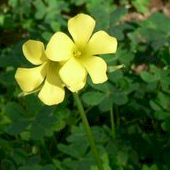|

Wood Sorrell |
This elegant little herb, called also French Sorrel, Rabbits' food, Shamrock, and Wood Sour (Oxalis acetosella), is abundant throughout our woods, and in other moist, shady places. It belongs to the natural order of Geraniums, and bears the provincial names of Sour trefoil, Cuckoo's bread, or Gowk's-meat, and Stubwort (from growing about the stubs of hewn trees). Its botanical title is got from the Greek word oxus, sharp, or acid, because of its penetrating sour taste.
This is due to the acid oxalate of potash which it contains abundantly, in common with the Dock Sorrel, and the Garden Rhubarb.
By reason of this chemical salt being present in combination with less leafy |
matter than in the other plants which are akin to it, the Wood Sorrel makes a lighter and more palatable salad.
In olden days the Monks named this pretty little woodland plant Alleluia, because it blossoms between Easter and Whitsuntide, when the Psalms--from the 113th to the 117th, inclusive--which end with the aspiration, "Hallelujah!" were sung.
St. Patrick is said to have shown on the ternate leaf of the Wood Sorrel to his rude audience the possibility of a Trinity in Unity.
The herb has been long popular as a Simple for making a fever drink, which is thought to be somewhat sedative to the heart, and for helping to cure scurvy. Also, it has proved useful against intermittent fever.
Towards assisting to digest, by their free acid, the immature fiber of young flesh meats, the Wood Sorrel leaves are commonly eaten as a dressing with veal, and lamb. But too habitual use of such a salad or sauce has led to the formation of gouty crystals (oxalate of lime) in the urine, with considerable irritation of the kidneys. Externally, the bruised leaves are of excellent service for cleansing and stimulating foul sores and ulcers, being first macerated in a Cabbage
leaf with warmth.
This familiar harbinger of Spring, with its three delicate leaflets on a long stalk, and its tiny white flowers, having purple veins like those of the Wood Anemone, bears the fanciful name of Fairy-bells in Welsh districts.
Fra Angelico placed the claret-stained flowers in the foreground of his pictures representing the Crucifixion. After the doctrine of signatures, because of its shape like a heart, the leaf of the Wood Sorrel was formerly esteemed as a cordial medicine. It was called in Latin "Panis Cuculi", meaning the "Cuckoo's bread and cheese." The leaves, when bruised, make with sugar a capital conserve which is refreshing to a fevered stomach, or, if boiled in milk, they form an
agreeable sub-acid whey. Twenty pounds of the fresh plant will yield four ounces of the oxalate of potash, commonly known as salt of lemons or salt of sorrel, which is often used for taking ink stains out of linen. Francus, an old classical author, concluded by experiment that the herb is of value (cordis vires reparare) to recruit the energies of the heart, and (anginum abigere) to dispel the quinsy. Its infusion makes an excellent anti-putrescent gargle. There is also a
yellow variety of the Wood Sorrel.
Herb Simples
The Primitive Simplers presented here show the way of life in other generations, it is not suggested or recommended trying them yourself. |
|
Garden
Herbs
Home
History of Herbs
Herb Gardening
Herbs for Beginners
Drying & Preserving Herbs
Indoor Herb Gardening
Herb Garden
Hints & Tips
Herbal
Cooking
Herb Chart
Using Herbs
Culinary Herbs
Herb
Oil and Vinegar
Herb Teas
Herb Candy
Herb Jelly
Herb Simples
Preface
Introduction
Alphabetical Listing

Trade
Recipes Online
Share your Recipes with others!!
|


